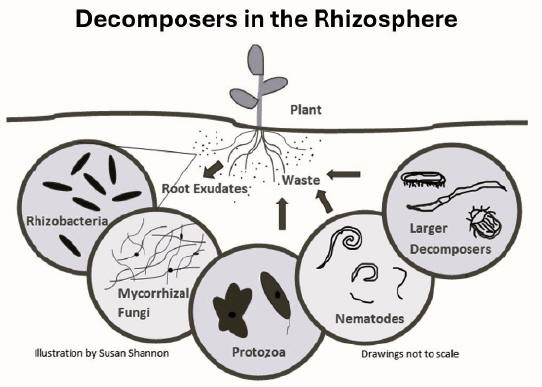Days are getting longer...I tried, unsuccessfully, to pause my thinking about healthy soil for the past couple of months. Now, as we approach warmer, longer days I embrace learning more.
If you feed them, they will come. Did you host or attend a gathering over the holiday season? I bet food was included. Food tends to make gatherings better...for humans and plants!
You may say, "Wait a minute, plants make their own food." They do! Via photosynthesis plants use sunlight, carbon dioxide from the air, and water from the soil to create carbohydrates. However, in order for plants to thrive, environmental factors like light, temperature, water, humidity, and nutrition must balance plants’ specific needs.
Let’s dig deeper to learn more about the nutrition that is made available to plants from decomposers in the soil. Good nutrition can help make a plant thrive and build strong defenses against plant pathogens, similar to the way nutritious food can improve human health.

The nutrient exchange begins in the rhizosphere, the area of soil where plant roots are found. Plant roots release exudates, compounds that include carbohydrates, into the soil. These exudates attract microscopic decomposers, specifically rhizobacteria and mycorrhizal fungi. These magnificent microscopic decomposers living in the rhizosphere initiate the decomposition of organic matter in the soil.
A well-structured soil with a large population of rhizobacteria and mycorrhizal fungi can support a large population of protozoa, nematodes, worms, etc. The waste produced from these larger decomposers contains nutrients in a soluble form that is readily accessible for the plant, improving the plant’s hardiness and resistance to disease. A well-structured soil contains sufficient minerals, air spaces, water, and organic content including living and non-living plant and animal materials
So, given a well-structured soil and active populations of decomposers, this is what is going on in the rhizosphere:
1. Plants excrete exudates for the rhizobacteria and mycorrhizal fungi. These microbial populations flourish close to healthy roots in a well-structured soil.
2. Protozoa and nematodes feed on rhizobacteria and mycorrhizal fungi, and their populations expand as well.
3. Larger decomposers including millipedes, worms, insects, beetles move in to feed on the smaller decomposers and other organic litter.
These active decomposer communities produce a lot of waste. It is the waste of these decomposers that contains the nutrients in a soluble form that plants can utilize. With macro and micro nutrients now readily accessible in the soil, plant roots can retrieve these soluble nutrients through osmosis. A plant that is supplied with most of the micro and macro nutrients it needs is a strong healthy plant that can more easily tolerate less than adequate environmental conditions and pathogens.
There is a lot going on below the surface of the soil. Whole ecosystems, biological communities, are living, gathering, feeding and dying beneath our feet. These living communities make nutrients accessible for plants. These living communities’ matter to all of us. Nutrients in the soil’s minerals and organic matter are not available to plants without these decomposer communities.
Step outside on the earth. Step lightly. Consider the life beneath your feet. How can we support this life? Does the soil need more organic matter to help improve its physical structure and feed the decomposers? Does the soil need more plants with their healthy roots providing exudates to the rhizobacteria and mycorrhizal fungi? The soil may need both. If we feed them and support their environment, they will thrive.